
130
HNUE JOURNAL OF SCIENCE
Educational Sciences 2024, Volume 69, Issue 5B. pp. 130-136
This paper is available online at http://hnuejs.edu.vn/es
DOI: 10.18173/2354-1075.2024-0141
USING GEOGEBRA FOR TEACHING PROBLEMS ON FIXED POINTS
OF FAMILIES OF LINES AND CIRCLES IN SECONDARY SCHOOL GEOMETRY
Chu Minh Chau1, Vương Thi Quynh2, Tran Le Thuy3,* and Nguyen Hoang Vu4
1Quang Trung High School, Ha Dong, Hanoi city, Vietnam
2Faculty of Pedagogy, Graduate Student of University of Education,
Vietnam National University, Hanoi city, Vietnam
3Faculty of Pedagogy, University of Education, Vietnam National University,
Hanoi city, Vietnam
4Pi Journal, Vietnam Mathematical Society
*Corresponding author: Tran Le Thuy, e-mail: tranlethuy@vnu.edu.vn
Received May 28, 2024. Revised November 12, 2024. Accepted December 27, 2024.
Abstract. This paper explores the application of GeoGebra software to assist teachers and
students in lessons on fixed points of families of lines and circles, a relatively complex topic
in secondary school geometry that requires logical reasoning and advanced proof skills.
GeoGebra, as a visual modeling tool, enables the discovery and proof of fixed points in
problems involving families of lines and circles. The selected illustrations are derived from
problems featured in competitions for high-achieving students and specialized 10th-grade
entrance exams in recent years. To evaluate the effectiveness of this teaching method,
experiments were conducted with 59 Grade 9 students at Newton Secondary and High School
(Bac Tu Liem, Ha Noi). A t-test on students’ test scores after being taught fixed-point
problems showed statistically significant differences between the GeoGebra method group
(M = 7.07, SD = 1.64) and the traditional method group (M = 5.6, SD = 1.3) [t(59) =
1.987934, p = 0.001134 < 0.05]. Additionally, students in the experimental group
demonstrated greater interest in the presented problems. The findings from this study
highlight the potential of using GeoGebra to teach advanced geometrical problems within the
Vietnamese educational context.
Keywords: mathematics education, Geometry software, dynamic geometry.
1. Introduction
Families of lines or circles passing through a fixed point are a common type of advanced
problem for secondary school students. This type of problem is both interesting and challenging,
often posing difficulties for students in finding solutions [1].
In this article, the use of GeoGebra to find fixed points is illustrated. GeoGebra, a free
software application available for both PCs and smartphones, is widely used in teaching
mathematics. With support for the Vietnamese language, it is effective for teaching at both
elementary and college levels. Its integration of dynamic geometry and analytical calculation
makes it particularly convenient for combining geometry and algebra [2]. The use of GeoGebra

Using GeoGgebra for teaching problems on fixed points of families of lines and circles in Secondary school…
131
as an interactive and visual tool in teaching mathematics has been explored in several previous
studies by the authors [3]-[10]. In this context, GeoGebra has the potential to serve as an effective
tool for providing visualizations that help students discover solutions to problems involving fixed points.
The following section demonstrates how GeoGebra can be used in classroom settings with
promising experimental results. To find the fixed point, the problem can first be visualized in
GeoGebra. The point or line can then be moved to observe the common point of a family of lines
or circles. Alternatively, only three cases can be drawn to find the intersection of the lines or
circles. Based on this visualization, students can predict the properties of the fixed points and
attempt to develop a mathematical proof.
2. Content
2.1. Application of GeoGebra to problems involving fixed points
The process of teaching fixed-point problems using GeoGebra will be described in detail for
the first problem. For subsequent problems, the procedures are similar; therefore, only the
GeoGebra solutions and proofs are provided.
Problem 1: Given a circle with center O and a fixed chord AB. C is the point moving on the
small arc AB. Let M be the midpoint of BC. From M, draw MN perpendicular to AC (N AC).
Prove that the line MN always passes through a fixed point.
Solution:
• Step 1: Use Geogebra for setting up the lines or circles that move
Draw the circle with center O. Pick two points A and B on the circle. Draw the chord AB.
Draw diameter AD. Let C be a point on the arc AB. Draw line AC and use the tool inside
GeoGebra to find the midpoint M. Use the perpendicular line tool to draw MN perpendicular to AC.
• Step 2: Use Geogebra to visualize the movement and predict the fixed point(s) when C
moves along AB. Prediction: MN always passes through the midpoint of BD.
• Step 3: Instructions for proof: Teachers guide students to the solution with questions
The teacher asks students to extend MN to intersect BD at E and to prove that E is the
midpoint of BD.
-Teacher: Observe and comment on the relative positions between MN and CD when C
moves along the smaller arc AB.
-Student:
MN / /CD
(because 𝐴𝐶𝐷
= 𝐴𝑁𝑀
= 900).
Hence, students can use Thales’s theorem to conclude that E is the midpoint BD.
• Step 4: Verification: The teacher asks students to verify with tools in GeoGebra.
Figure 1. Fixed point of a family of lines for problem 2 in GeoGebra

Chu MC, Vương TQ, Tran LT* & Nguyen HV
132
Proof. Angles 𝐴𝐶𝐷
= 𝐴𝑁𝑀
= 900. Hence,
MN / /CD
. Since M is the midpoint of BC,
according to Thales’ Theorem, E is the midpoint of BD. As such, MN always passes through E.
Problem 2: Given circle (C) with center O and a point A inside (C) but not congruent with
O. A moving circle goes through A but not O intersects (C) at M and N. Prove that the
circumcircle of triangle OMN always passes through a fixed point different from O.
Solution: Draw a circle with center O. Select a point A inside the circle. Pick point M on the
circle. Line AM intersects (O) at N. Draw the circumcircle of triangle OMN using the tool inside
GeoGebra. Line AO intersects the circle (O) at C and D; and the circle (OMN) at B. Moving M
along the circle (O), the circle (OMN) always passes through a fixed point B (Figure 2).
Figure 2. Fixed point of a family of circles for problem 2 in GeoGebra
Proof. Since A and O are fixed, C and D are also fixed points. 𝛥𝐶𝐴𝑁 ∼ 𝛥𝑀𝐴𝐷 (angle-angle).
Hence,
CA AN
MA AD
=
, or
CA DA AN MA =
. Similarly, 𝛥𝐵𝑀𝐴 ∼ 𝛥𝑁𝑂𝐴 (angle-angle). Hence
AB AN
AM AO
=
or
AB AO AN AM =
. Consequently
AB AO AC AD =
or
AC×AD
AB= AO
Is
constant. Meanwhile, B is on the fixed line AO so B is also a fixed point.
Problem 3: Given circle (C) with center O and a line d outside of the circle. Point I moves
along d. The circle of diameter OI intersects (C) at M and N. This Proves that line MN always
passes through a fixed point.
Solution: Draw a circle with center O and line d. Select point I on d. Draw a circle with
diameter OI, which intersects (C) at M and N. Draw OA perpendicular to d, intersecting MN at
B. As I move along d, MN always passes through the fixed point B.

Using GeoGgebra for teaching problems on fixed points of families of lines and circles in Secondary school…
133
Figure 3. Fixed point of a family of the line for problem 3 in GeoGebra
Proof. Triangles OCB and OAI are similar. Hence
OC OA
OB OI
=
or
OC OI OA OB =
.
Triangle IMO is a right triangle. Hence
22
OC OI OM R = =
. So
2
OA OB R=
so OB is of
constant length. Point B is on the perpendicular line to d from O so B is a fixed point.
Problem 4: Given half circle with diameter AB. C is a point on this half-circle. On the outside
of the triangles, ABC draws the squares BCDE and ACFG. Let Ax and By be the tangents of the
half circles. Prove that when C moves along the half circle, the line ED always passes through a
fixed point. Do the same for line FG.
Solution: Draw the half circle with Diameter AB and the tangents Ax, By perpendicular to
AB. Let C be a point on arc AB. Construct squares CBED and CAGF using the tool for regular
polygon in GeoGebra. DE intersects By at I, GF intersects Ax at K. I and K are fixed points.
Figure 4. Fixed point of a family of the line for problem 4 in GeoGebra
Proof. Right triangles ABC and BIE are congruent because 𝐼𝐵𝐸
= 𝐴𝐵𝐶
(𝐶𝐵𝐼
= 900) and
BC=BE. Hence BI=AB. So it is a fixed point. The same can be proven for K in a similar way. K
and I are also two vertices of the square of side AB.

Chu MC, Vương TQ, Tran LT* & Nguyen HV
134
Problem 5: Given the isosceles triangle ABC (AB =AC). D and E are points on AB and BC,
respectively, so that the projection of DE on BC is half of BC. This proves that the line
perpendicular to DE always passes through a fixed point.
Solution: Draw segment BC and its perpendicular bisector. Select point A on this bisector.
Connect AB and AC. Select point D on AB. E is the intersection of the circle
( )
F, BC / 2
and BC.
AD moves along AB, the line perpendicular to DE always passes through a fixed point on the
perpendicular bisector of BC.
Figure 5. Fixed point of a family of the line for problem 5 in GeoGebra
Proof.
EF BC / 2 BH.==
Hence
BF BH FH EF-FH=EH= − =
. 𝐸𝐷𝐹
= 𝐾𝐸𝐻
. So 𝛥𝐸𝐷𝐹 ∼
𝛥𝐾𝐸𝐻. Hence
DF ED
EH EK
=
or
DF DE
BF EK
=
FBD EKD
(SAS). Hence 𝐵𝐷𝐹
= 𝐾𝐷𝐸
⇒
𝐵𝐷𝐾
= 𝐸𝐷𝐹
. But 𝐸𝐷𝐹
= 𝐾𝐸𝐻
. So B, D, E, and K are concyclic and 𝐷𝐵𝐾
= 900. Hence K is a
fixed point.
Problem 6: Given circle (O) of diameter AB. On the tangent Ax to (O), select point C such
that
AC AB=
. Line BC intersects (O) at D. M is a point moving along line AD. N and P are
projections of M onto AB and AC, respectively. H is the projection of N onto PD. Prove that
when M moves, HN always goes through a fixed point.
Solution: Draw segment AB and circle with the diameter of AB. Draw tangent Ax of (O).
Select C as the intersection of this tangent and the circle (A, AB). D is the intersection of (O) and
BC. Select point M on segment AD. Draw the perpendicular lines to find N, P, and H. As M
moves along AD, HN always goes through a fixed point E on (O).
Figure 6. Fixed point of a family of the line for problem 6 in GeoGebra


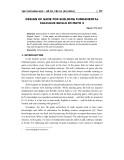

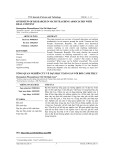

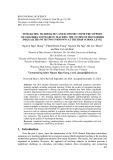


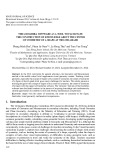
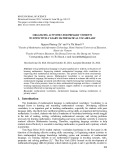



![Quy hoạch tổng thể Cà Mau: Tài liệu [mới nhất/chuẩn nhất]](https://cdn.tailieu.vn/images/document/thumbnail/2025/20250827/tghong1621@gmail.com/135x160/49401756278390.jpg)


![Bài giảng Hàng hải địa văn [chuẩn nhất]](https://cdn.tailieu.vn/images/document/thumbnail/2025/20250729/vijiraiya/135x160/43361753782101.jpg)
![Bài giảng Trắc địa cơ sở [mới nhất]](https://cdn.tailieu.vn/images/document/thumbnail/2025/20250729/vijiraiya/135x160/84_bai-giang-trac-dia-co-so.jpg)





![Atlas tài nguyên nước Việt Nam: Tài liệu [Mô tả/Hướng dẫn/Chi tiết]](https://cdn.tailieu.vn/images/document/thumbnail/2025/20250715/vijiraiya/135x160/348_tai-lieu-atlas-tai-nguyen-nuoc-viet-nam.jpg)
![Hệ thống câu hỏi ôn tập Vùng kinh tế [chuẩn nhất]](https://cdn.tailieu.vn/images/document/thumbnail/2025/20250709/kimphuong1001/135x160/76921752140578.jpg)
